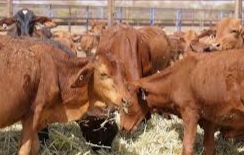After being largely shut out of the market for two years, China has relaxed its restriction on hay exports.
About 25 Australian hay exporters have been unable to renew their China trade permits since the beginning of 2021.
Prior to the prohibition, Australia sent 360,000 metric tonnes of hay to China for a total cost of around $160 million.
While three Australian hay producers still have permission to sell to China, the trade has decreased to an anticipated 60,000 tonnes for the year 2022–2023.
The federal government announced late yesterday that the trading ties had been mended and that trade with China would soon resume with “establishments registered for import into China” once more.
It follows the August resumption of trade in Australian barley with China, but Australian wine, along with some cattle and seafood goods, continue to be subject to high tariffs and a trade embargo in China.
The full restart of the hay trade was described by Trade Minister Don Farrell as a “positive step forward, but there is more work to do,” although no specific timeframe was given.
I will persist and push to get all remaining obstacles to lobster, wine, and meat removed as quickly as feasible,” he stated.
Additionally, they have been working to diversify their customer base.
“Some of our competitors have entered Vietnam, while we do a little bit of business in Indonesia.”
The hay trade to China may resume in a matter of weeks, according to Mr. Patchett, who claimed that the announcement completely caught him off guard.
My impression is that the hay market is now open moving forward, but our clients or the clients must submit applications for import permits, he said.
Therefore, I predict that more shipments will be leaving Australia for China in the next weeks.
Colin Peace, a hay analyst with Jumbuck AG based in Melbourne, said the lifting of the embargo was a relief for the entire business. Before Beijing decided not to renew most export licences in February 2021, the industry sent around one third of its hay to China.
According to him, China is one of just four nations importing 90% of the hay that Australia exports. Therefore, Australian farmers will benefit from China’s return to buying, especially those in Western Australia, where 60–70% of their whole harvest is exported.
Market diversity is something we need, and the business community is working to get it, Mr. Peace added.
He claimed that given the seasonal improvements over the subpar harvest caused by the floods caused by La Nia last year, the timing of the announcement couldn’t have been better.
The timing of [the announcement] is appropriate because we currently have excellent curing conditions for making hay, according to Mr. Peace.





